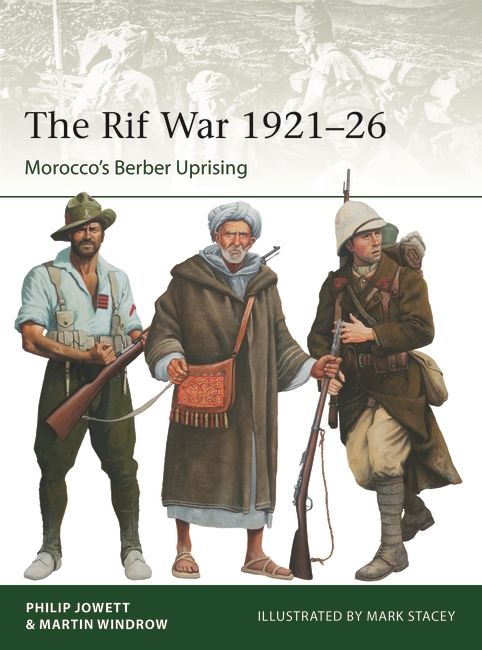
I have greatly enjoyed being able to co-author this title with Philip Jowett. Obviously, I owe my interest in the subject to my research into the campaigns of the French Foreign Legion, which played a late, relatively brief, but extremely dramatic part in this three-sided war.
The early victories of the great Moroccan Berber leader Mohammed Abd el Krim el Khattabi attracted world-wide attention. In fact, the sequence of events that really brought the Legion international fame began with media coverage of a major Berber victory over the Spanish in 1921; continued in 1924 with the publication of P.C. Wren’s fanciful novel Beau Geste, and culminated with the extension of the Rif War into French Morocco in 1925. I was able to devote a long chapter to France’s 1925-26 campaign in my book Our Friends Beneath the Sands: The Foreign Legion in France’s Colonial Conquests 1870-1935 (Weidenfeldt & Nicolson , 2010). Of course, that task forcibly reminded me that from 1909 up to 1925 the colonial fighting in the northern coastal region of Morocco, centred on the Rif highlands, was in fact carried out by the Spanish Army rather than the French.
My wish to submit a book on the Rif War to Osprey was long hampered by the limited English-language (or even French) sources for military detail, and my own inability to read Spanish. I was therefore delighted when Osprey’s veteran contributor Philip Jowett mentioned his own interest in the subject, and his photo research in Spanish sources. He kindly agreed to a co-authorship effort, and has been a pleasure to work with over the past couple of years. Again, we were both lucky in that Helion Books coincidentally published a two-volume study by Javier Garcia de Gabiola in 2021 and 2023, to which Philip and I acknowledge our considerable debt. Our approach has been to cover the background and the early Spanish campaigns of 1909 to 1921 at modest length (leaning on the published works of Señor Garcia, and of José Maria Bueno back in the 1980s), followed by fuller material on the events, units and uniforms from the Spanish disaster at Anual in July 1921 to the final joint Franco-Spanish victory in May 1926.
The story includes many examples of desperate fighting and heroic resistance, but much of its interest lies in the great differences between the Spanish Army, the Berber resistance, and the French Army. Initially, the neglected and usually badly-led Spanish conscript army achieved little, and Spain’s neutrality in World War I prevented its benefitting much from the lessons of 1914-18. However, after the shock of Anual in 1921 it gradually progressed – spearheaded by the best officers of the locally-raised Regulares, and of the largely Spanish volunteers of the Tercio (Spanish Foreign Legion) – and by mid-1925 its performance following the Alhucemas amphibious landings showed a transformational improvement. The Berbers – always formidable guerrillas – owed their stunning early successes to the brothers Abd el Krim, who created an unprecedented pan-tribal alliance that lasted for five years, and trained it to make use of great numbers of modern weapons. The French historically more sucessful in their more southern zone of Morocco, were locally outnumbered by Abd el Krim’s shock attacks in April 1925, and the first desperate months proved the limits of Marshal Lyautey’s traditional colonial tactic. However, in August-September Marshal Pétain’s massive reinforcements from the Rhineland occupation army brought divisions of infantry with artillery, aircraft, tanks, and 1918 Western Front tactics. Together, the Spanish and French armies crushed Berber resistance the following spring.
Our final grateful acknowledgements for assistance in telling the story of this greatest colonial war of the inter-World War period must go to our colour illustrator, Mark Stacey, for his skill in capturing not only the facts but also the character from our inevitably fragmented references; and to Ramon San Emiterio, for his generously patient Spanish translation work.
Order your copy of The Rif War 1921–26: Morocco's Berber Uprising here.

Comments
You must be logged in to comment on this post. Click here to log in.
Submit your comment